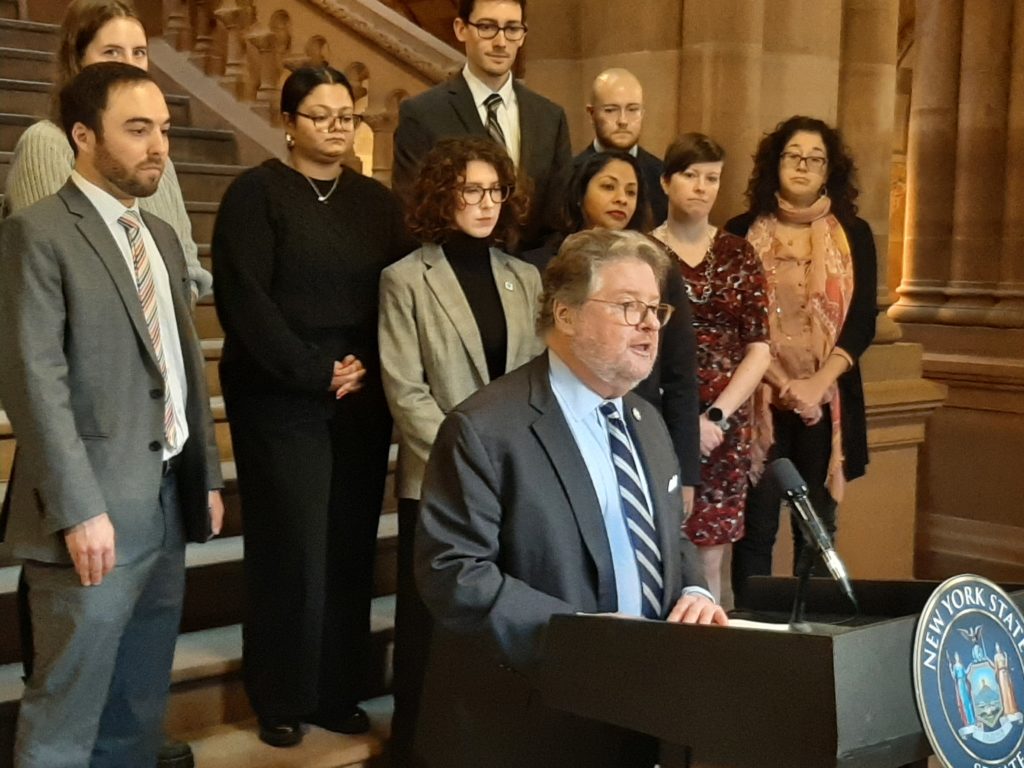
Albany, NY – New York State Senator Pete Harckham and representatives from a number of important environmental groups held a press conference in the New York State Capitol today urging Governor Hochul to enact vital legislation that protects streams and drinking water throughout the state.
Gathered in front of the Million Dollar Staircase inside the Capitol building, Harckham and numerous advocates spoke of the landmark bill (S.4162 / A.6652) that will ensure proper access to waterways that are used for drinking water, fishing and recreation by adding Class C streams to those waterways included in the New York State Department of Environmental Conservation (DEC) Protection of Waters Regulatory Program.
The bill, introduced by Harckham and Assemblyman Steve Englebright, was passed by the State Legislature in May 2022. Governor Hochul has until December 14 to sign the legislation into law.
“The only way we can be responsible stewards of our environment and natural resources is by tirelessly protecting our streams and waterways,” said Harckham. “This legislation commits us to this effort in order to maintain the quality of our drinking water while still permitting residents to enjoy non-contact activities on certain waterways.”
“Protecting New York’s freshwater streams is essential to the health and vitality of New York’s environment, recreation and public heath,” said Englebright, chair of the Assembly Environmental Conservation Committee. “This legislation will protect streams across the state and help ensure these valuable resources and ecological treasures are safeguarded for future generations. I look forward to the Governor signing this important legislation.”
Harckham and Englebright’s bill grew out of the Trump administration’s rollback of federal clean water protections in January 2020, which were in place since the Clean Water Act was passed in 1972 and were later strengthened under President Obama. The rollback ended up affecting about 50% of the streams statewide.
In New York, however, Class AA and A streams (drinking water sources), Class B streams (swimming and contact recreation) and Class T and TS streams (supporting trout populations and trout spawning) have been afforded the extra, longstanding DEC protection. This legislation aims to protect Class C streams (supporting fisheries and non-contact recreation) similarly.
Maureen Cunningham, council member for the Town of Bethlehem, said, “Streams are so vital to our safe drinking water and our public health. In the Town of Bethlehem, we have been proactive in protecting our land and water, with some of the most forward-thinking conservation initiatives in the state. That said, we can’t do it alone at the municipal level—we need strong partners at the state level to protect clean water.”
Julie Tighe, president of the New York League of Conservation Voters, said, “We at the New York League of Conservation Voters believe it is vital that Class C Streams be added to the Protection of Waters Regulatory Program, allowing the DEC to protect even more of the state’s all-too-vulnerable natural resources. By extending the protection of Class C Streams, we will help ensure the long-term health of fisheries and, critically, will shore up the state’s natural resilience against the impacts of climate change. We thank Senator Harkham and Assemblyman Englebright for their leadership on this issue and we join them in urging Governor Hochul to sign this legislation—a 2022 State Environmental Scorecard bill—to protect our Class C Streams without delay.”
More than 11.2 million New Yorkers are dependent on public water systems that rely on small streams to supply clean drinking water. In addition, a recent DEC Angler Survey showed that New York State freshwater sport fisheries generate more than $2 billion a year and support nearly 11,000 jobs statewide, providing undeniable economic proof of why it is vitally important for New York State to preserve and protect its Class C waterways.
Carli Fraccarolli, state policy coordinator for Scenic Hudson, said: “In the face of increased flooding due to climate change, the homes and businesses of thousands of Hudson Valley residents are at risk. Natural resources like streams and waterways are often one of the first lines of defense for communities facing hurricanes and severe storms. Class C streams are an important part of this equation, protecting New Yorkers in flood-prone areas. We respectfully urge Governor Hochul to sign this bill and ensure there is a system in place to protect this natural infrastructure. The health and well-being of New York’s residents depends on it.”
Erin McGrath, senior policy manager for Audubon New York, said, “Streams throughout New York State provide essential habitat for birds and other wildlife. Birds need clean water and healthy ecosystems that provide food, healthy breeding habitat, and places to rest during migration, and many Class C streams provide these important resources for birds. When streams are altered, degraded, or even eliminated, the birds depending on those waters face serious risks. Audubon believes that New York State must step up and ensure that our Class C streams are protected, and we thank Senator Harckham and Assemblymember Englebright for championing this bill. We ask Governor Hochul to join the Assembly and Senate in these efforts by enacting this legislation into law.”
Rob Hayes, director of clean water with Environmental Advocates NY, said, “On Election Day, voters overwhelmingly approved the Environmental Bond Act. From Buffalo to Long Island, New Yorkers stated loud and clear that they want more clean water protections, not fewer. Now Governor Hochul has the opportunity to protect over 40,000 miles of New York streams. Healthy streams are critical for healthy drinking water. We urge the Governor to sign this bill into law as soon as possible.”
When signed into law, this legislation will extend DEC protections to over 40,000 miles of Class C streams across New York, including Tonawanda Creek and Cayuga Creek in Western New York and the streams in both the Upper Hudson River and Lower Hudson River basins. These protections prevent course modification, bank disturbance and infilling of all Class C headwater streams.
The Protection of Waters Regulatory Program includes exemptions for some agriculture and irrigation activities, as well as removal of fallen trees and debris. Town and county governments may enter into written agreements with DEC for specified categories of work, such as necessary clean up and repair work from storms and other emergency situations. Each of these exemptions will also apply to newly protected class C streams.
“This bill is essential to protecting 41,000 miles of vulnerable streams, including tributaries in Putnam County that run directly to the drinking water supply to 58,900 neighbors,” said Putnam County Legislator Nancy Montgomery. “Our local Soil and Water boards are not staffed with trained experts equipped to protect our most important resource. The state must help local governments protect our water.”
Adrienne Esposito, executive director for Citizens Campaign for the Environment, said, “New York’s class C streams may be small, however the benefits they provide for drinking water, flood protection, and aquatic habitat are huge. With climate change exacerbating the many threats to our waterways, it is critical that New York step up and provide additional protections for these important and vulnerable waters without delay. We urge Governor Hochul to sign this important clean water bill into law.”
Many public water systems across New York State are fed by streams that are currently designated Class B, C, or D. In communities such as Peekskill and Watervilet, where the public water supply is fed by Class C Streams, the protection of these streams could not be more paramount. Nearly 60,000 people across Peekskill, Buchanan, and Cortlandt rely on Peekskill’s water supply, with another 37,000 people in the City of Watervliet and Town of Guilderland relying on a reservoir fed by Class C streams as their primary source of water.
Class C streams also safeguard New Yorkers against major flooding by reducing water velocity. Hurricane Ida showed the devastating effects that flooding can cause in New York state: property damage, road closures and washouts, and even deaths. As the severity and frequency of storms increase, new protections for Class C streams are needed now more than ever. This natural infrastructure is an efficient tool to protect the region’s economy and reduce the costs of flooding.
Jessica Ottney Mahar, The Nature Conservancy’s New York policy and strategy director, said, “The Nature Conservancy commends Senator Harckham for his leadership in expanding protections for small streams that provide wildlife habitat and help supply drinking water to New Yorkers throughout the state. Currently, more than half of New York streams have no state protection and are at risk from pollution, development, runoff, and invasive species. We appreciate the State Legislature for passing this legislation and urge Governor Hochul to expand stream protection by enacting this legislation.”
Katie Friedman, New York ecological restoration program manager for Save the Sound, said, “Save the Sound strongly supports this legislation, which will provide critical protections to class C streams in New York. Every stream, regardless of classification, provides an important opportunity for improving water quality and habitat in the Long Island Sound watershed and estuary. New Yorkers deserve protected, connected streams, which are critical in strengthening community and ecological resiliency in the face of climate change, supporting biodiversity, and ensuring swimmable, drinkable, and fishable waters for all New York residents and wildlife. We urge Governor Hochul to sign this bill by the December 14 deadline to protect over 40,000 miles of class C streams rendered vulnerable by the upcoming Supreme Court ruling.”
Roger Downs, conservation director for Sierra Club, Atlantic Chapter. “Headwater streams are the lifeblood of New York’s clean drinking water supply, and for decades thousands of linear miles of these capillaries have been improperly classified by the state of New York, and subsequently left unprotected. Governor Hochul has shown tremendous leadership in protecting New York’s wetlands in the wake of federal and judicial rollbacks of the Clean Water Act. But filling that gap cannot be complete without addressing the protection of headwater streams as well.”
Jeremy Cherson, senior manager of Government Affairs for Riverkeeper, said: “Riverkeeper urges Governor Hochul to sign Senator Harckham and Assemblyman Englebright’s legislation protecting freshwater streams across New York. Many of the streams that stand to gain protection under this legislation are sources of drinking water across the state, provide flood resilience, and provide wildlife habitat. The streams identified in this legislation lack basic protection from stream bank disturbance and other alterations that can degrade water quality and habitat. For communities across New York that rely on class C streams to feed their primary source of drinking water, the stakes could not be higher.”
